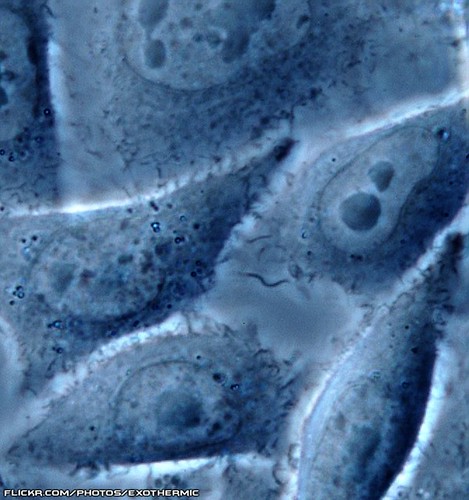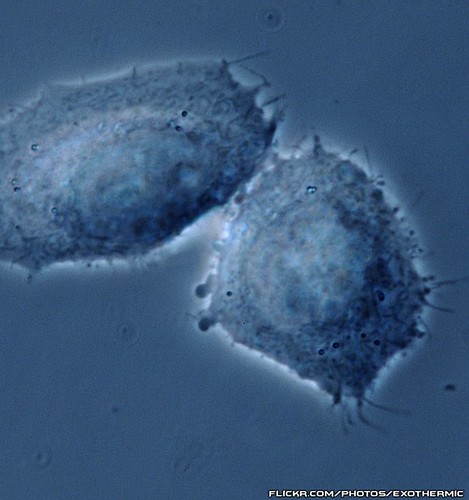Some cool cell membrane images:
CHO Phase Contrast Image-3
Image by Exothermic
Several live Chinese Hamster Ovary (CHO) cells in vitro as viewed through a phase contrast microscope. Visible in the photo are nuclei, nucleoli, mitochondria, and the cell boundary defined by the plasma membrane as well as other yet to be identified cellular structures.
For the next few weeks I will be working with these Chinese Hamster Ovary (CHO) cells in my Molecular Cell Biology course at MTSU. You are looking at an original picture of a group of these cells that we photographed using laboratory equipment (this is not a copy of an image from another source.) These are wild type CHO-K1 cells, the original cell line of which was started in 1957 by T.T. Puck. These cells grow in a monolayer on the bottom of the culture flask. CHO cells are commonly used in biological, genetics and medical research.
Using phase contrast microscopy allows the cells to be viewed live with out traditional staining which requires that the cells be fixed and results in quietus of the organism. Since the cells are living during observation, movement and activity of subcellular components can be easily viewed.
CHO Phase Contrast Image-2
Image by Exothermic
Several live Chinese Hamster Ovary (CHO) cells in vitro as viewed through a phase contrast microscope. Visible in the photo are nuclei, nucleoli mitochondria, and the cell boundary defined by the plasma membrane as well as other yet to be identified cellular structures.
For the next few weeks I will be working with these Chinese Hamster Ovary (CHO) cells in my Molecular Cell Biology course at MTSU. You are looking at an original picture of a group of these cells that we photographed using laboratory equipment (this is not a copy of an image from another source.) These are wild type CHO-K1 cells, the original cell line of which was started in 1957 by T.T. Puck. These cells grow in a monolayer on the bottom of the culture flask. CHO cells are commonly used in biological, genetics and medical research.
Using phase contrast microscopy allows the cells to be viewed live with out traditional staining which requires that the cells be fixed and results in quietus of the organism. Since the cells are living during observation, movement and activity of subcellular components can be easily viewed.
Cool Cell Membrane images
No comments:
Post a Comment